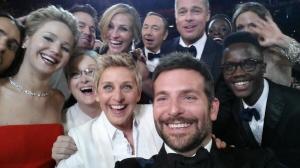THE MOST TALKED ABOUT MOMENT of the 2014 Academy Awards, other than John Travolta’s mangling of a singer’s name, was the all-star “selfie orchestrated by host Ellen DeGeneres. 
It was a great moment. It was fun, it was entertaining — but it wasn’t real.
Spontaneous moments do happen at the Oscars, such as Jennifer Lawrence tripping on her way to the stage or a host making a quip about a presenter or a winner’s speech. But this was a comedy “bit” — a slice of pseudo reality planned in advance (but not by Samsung, who said its Oscar sponsorship did not include Ellen’s Selfie act.)
This is what Selfie culture has created: The illusion of the Real. It’s not candid camera; it’s a reality show of the self.
A celebrity gets other celebrities to take a picture of themselves, and instructs the public to share that photo with their friends. And we did, breaking a Twitter “record” that only matters to people who care about records that don’t matter.
But that’s not all — we then digitized other celebrity faces on the photo, and even inserted our own faces, creating the ultimate self portrait with the stars.
I get the fun and I personally enjoyed the photo — and I was glad to see that Samsung decided to donate $3 million to charity, or $1 dollar for every retweet of of the photo taken with Ellen’s loaned device.
I even liked the pizza delivery, if only to see the look on Harvey Weinstein’s face when asked for money.
But at what point do we stop pointing cameras at ourselves and look around again? And when we stop looking into the camera and start looking into the mirror, will we like what we see?
Selfies can be extremely powerful storytelling tools. They can reveal truths before unseen, emotions that belie the trope of words.
But selfies can also be masks. They can obscure and mislead. And at their worst, they can trick us into using social media without being social at all.
